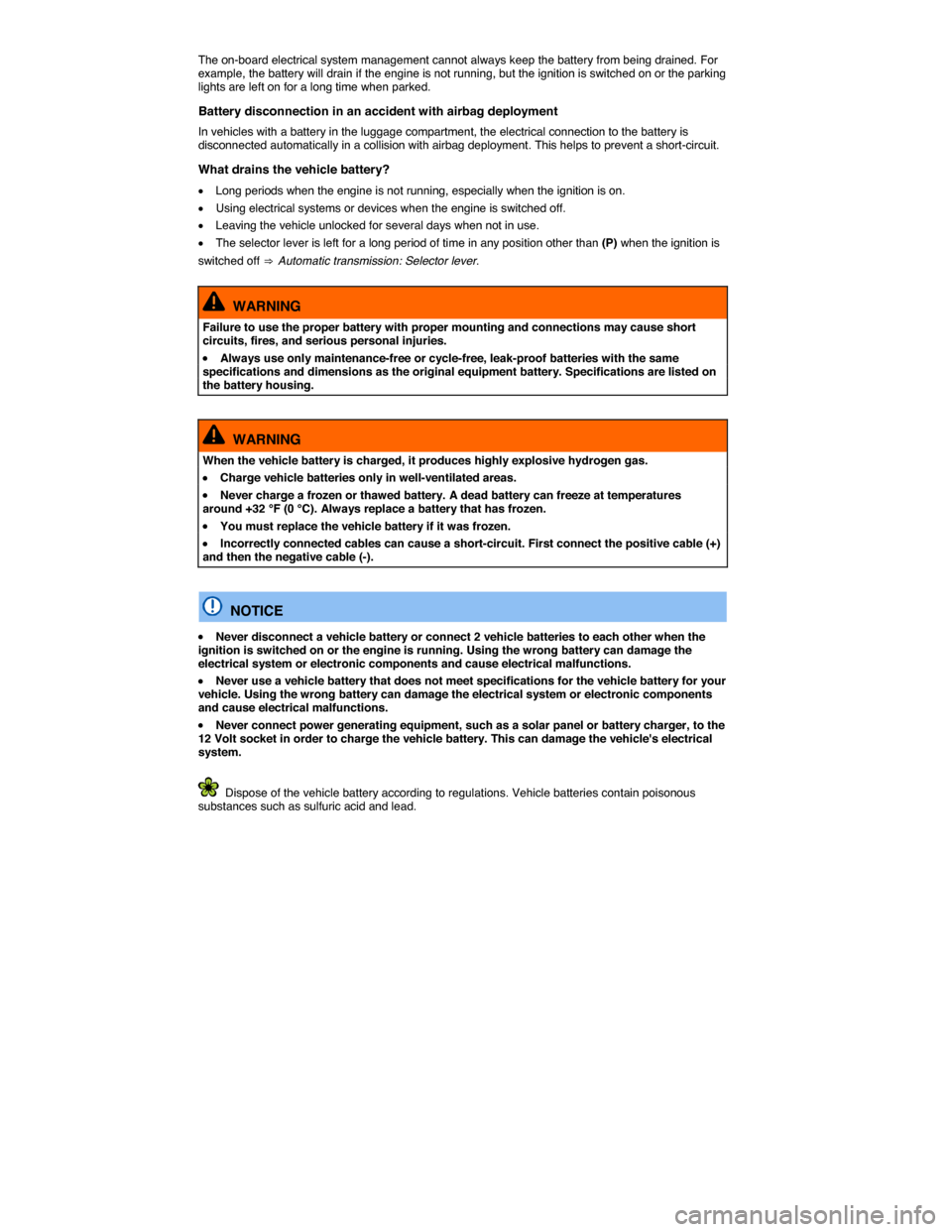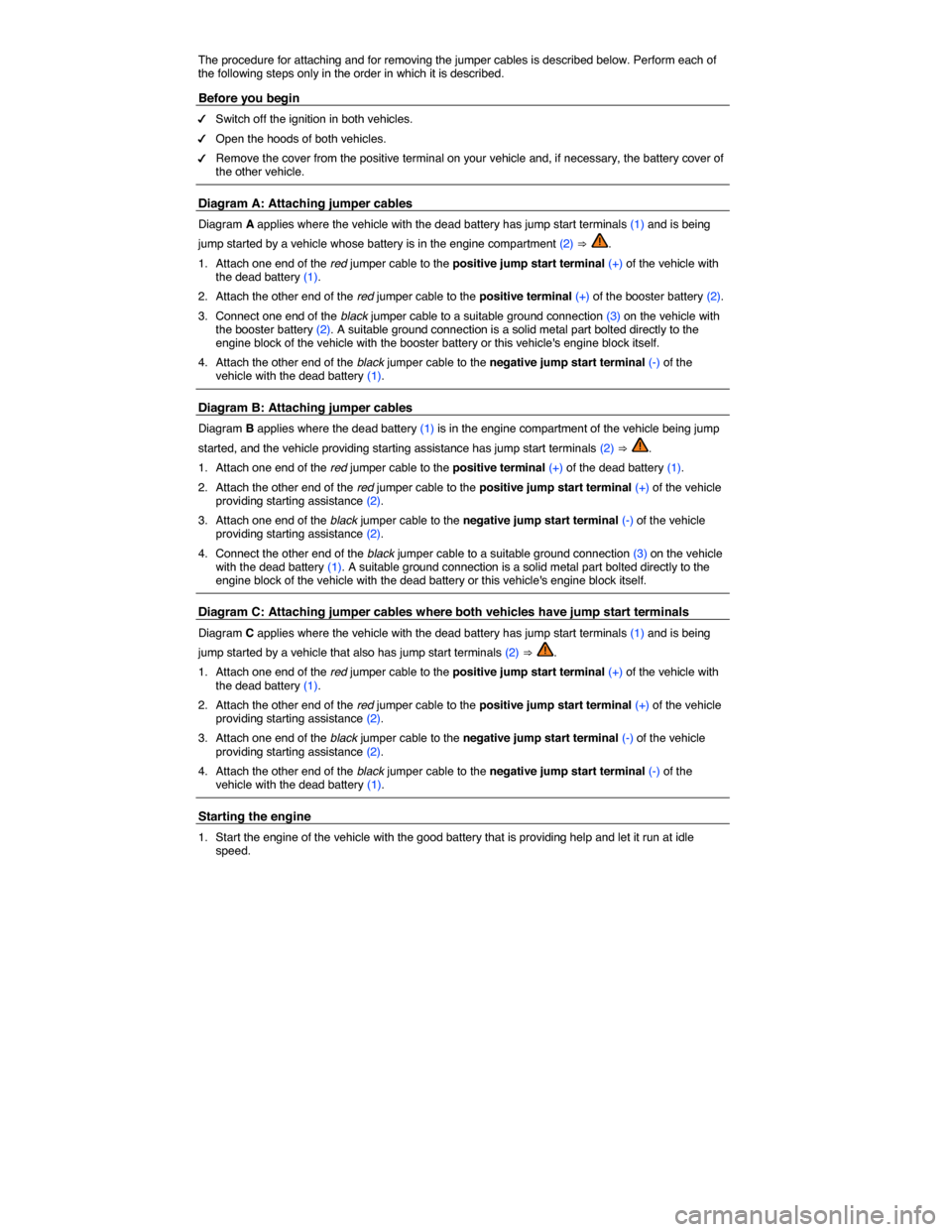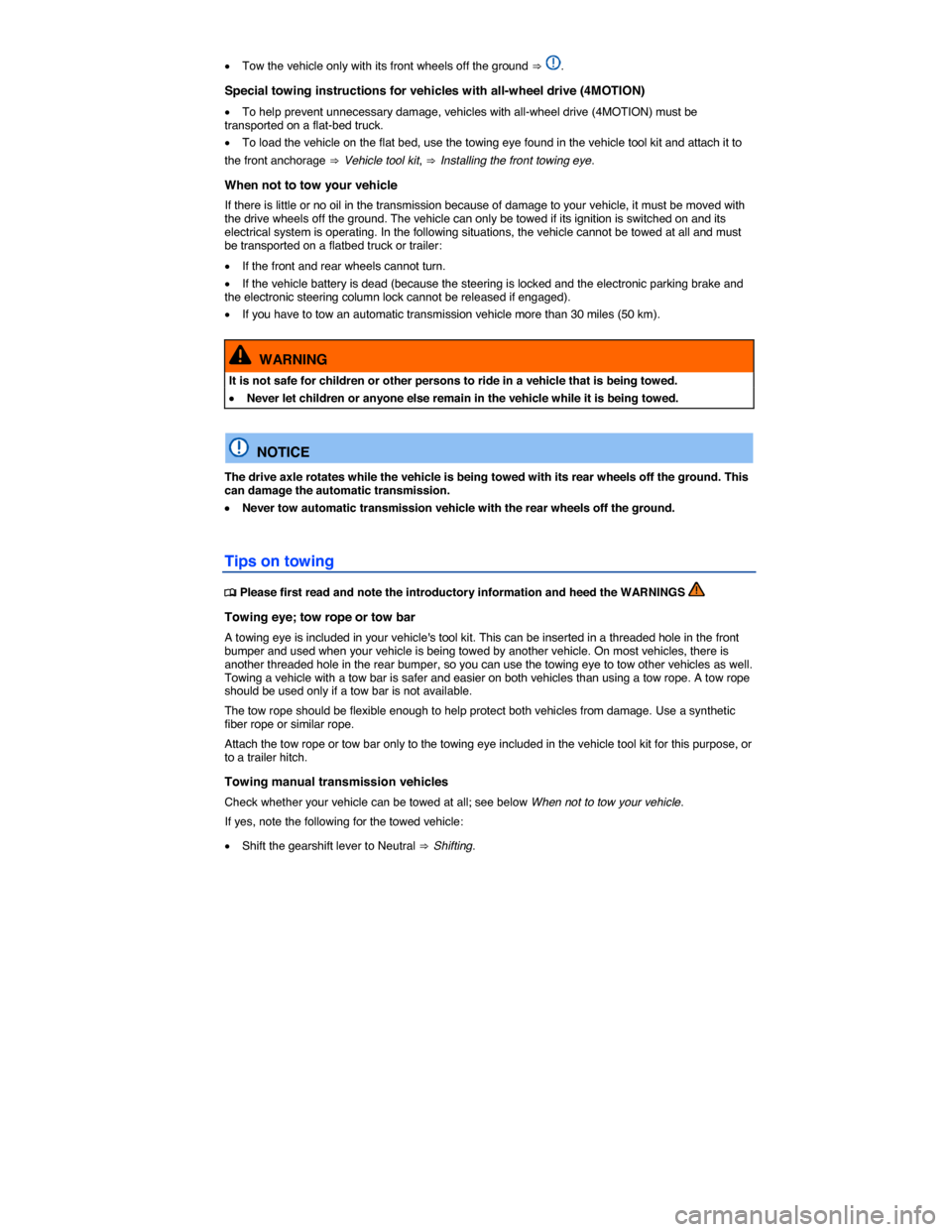2014 VOLKSWAGEN TOUAREG dead battery
[x] Cancel search: dead batteryPage 490 of 620

The on-board electrical system management cannot always keep the battery from being drained. For example, the battery will drain if the engine is not running, but the ignition is switched on or the parking lights are left on for a long time when parked.
Battery disconnection in an accident with airbag deployment
In vehicles with a battery in the luggage compartment, the electrical connection to the battery is disconnected automatically in a collision with airbag deployment. This helps to prevent a short-circuit.
What drains the vehicle battery?
�x Long periods when the engine is not running, especially when the ignition is on.
�x Using electrical systems or devices when the engine is switched off.
�x Leaving the vehicle unlocked for several days when not in use.
�x The selector lever is left for a long period of time in any position other than (P) when the ignition is
switched off ⇒ Automatic transmission: Selector lever.
WARNING
Failure to use the proper battery with proper mounting and connections may cause short circuits, fires, and serious personal injuries.
�x Always use only maintenance-free or cycle-free, leak-proof batteries with the same specifications and dimensions as the original equipment battery. Specifications are listed on the battery housing.
WARNING
When the vehicle battery is charged, it produces highly explosive hydrogen gas.
�x Charge vehicle batteries only in well-ventilated areas.
�x Never charge a frozen or thawed battery. A dead battery can freeze at temperatures around +32 °F (0 °C). Always replace a battery that has frozen.
�x You must replace the vehicle battery if it was frozen.
�x Incorrectly connected cables can cause a short-circuit. First connect the positive cable (+) and then the negative cable (-).
NOTICE
�x Never disconnect a vehicle battery or connect 2 vehicle batteries to each other when the ignition is switched on or the engine is running. Using the wrong battery can damage the electrical system or electronic components and cause electrical malfunctions.
�x Never use a vehicle battery that does not meet specifications for the vehicle battery for your vehicle. Using the wrong battery can damage the electrical system or electronic components and cause electrical malfunctions.
�x Never connect power generating equipment, such as a solar panel or battery charger, to the 12 Volt socket in order to charge the vehicle battery. This can damage the vehicle's electrical system.
Dispose of the vehicle battery according to regulations. Vehicle batteries contain poisonous substances such as sulfuric acid and lead.
Page 527 of 620

Frequently asked questions
If you suspect a malfunction or vehicle damage, read and follow the following advice before contacting an authorized Volkswagen dealer or an authorized Volkswagen Service Facility. You may also find helpful information under “Characteristics” and “Checklist” in the index.
Description Possible causes among others Possible remedy
Engine does not start.
Vehicle battery dead. – Perform jump start – Charge vehicle battery
The wrong remote control vehicle key is used. Use a valid remote control vehicle key
Fuel level too low. Refuel
AdBlue fill level too low. Refill AdBlue
Vehicle cannot be locked or unlocked using remote control vehicle key.
– Battery in remote control vehicle key dead. – Too far away from vehicle. (out of range). – Buttons have been pressed too many times.
– Replace battery –. Move closer to vehicle. – Synchronize remote control vehicle key – Lock or unlock vehicle manually
Unusual noises. Cold engine, brake-assistance systems, electronic parking brake.
Check the “Noises” entry in the keyword index.
Odd driving behavior. Assistance systems activated. Check the “Assistance systems” entry in the keyword index.
Driver seat and outer mirrors move when vehicle is unlocked.
Convenience settings are stored. Correct convenience settings
Memory-seat settings are stored. – Reassign seat setting – Clear memory-seat memory
Front seats cannot be adjusted with power controls.
Vehicle battery dead. Charge vehicle battery
Fuse blown. Check fuse and replace if necessary
No jack in vehicle or no collapsible spare tire or tire mobility set in vehicle.
Equipment differs depending on vehicle. No direct corrective action possible because this depends on the equipment. Contact an authorized Volkswagen dealer or an authorized Volkswagen Service Facility for assistance
Vehicle has mobility tires.
Features do not work as described in this Manual.
Settings were changed in the Volkswagen Information System or Infotainment System.
Check and reset to factory settings if necessary or
Headlights do not light up the road as they should.
– Headlights incorrectly adjusted. – Light bulbs burned out. – Low beams not switched on.
– Adjust headlight range – Change light bulbs – Switch on low beams
Electrical appliances do not work.
Vehicle battery charge too low. Charge vehicle battery
Remaining fuel level too low. Refuel
Page 578 of 620

WARNING
Improper use of jumper cables when jump-starting a vehicle with a dead battery can cause the battery to explode, leading to serious personal injury. To help reduce the risk of battery explosion:
�x All work on the batteries or the electrical system in your vehicle can cause serious acid burns, fires, or electrical shocks. Always read and heed the following WARNINGS and safety
precautions before working on the batteries or the electrical system ⇒ 12 Volt vehicle battery.
�x Always make sure that the battery providing starting assistance (the booster battery) has the same voltage as the dead battery (12 V) and about the same amperage capacity (see battery label).
�x Never jump-start a vehicle with a thawed or frozen battery. The battery can explode. A dead battery can freeze at temperatures around +32 °F (0 °C).
�x A battery that is frozen or was frozen, but has since thawed, must be replaced.
�x When the vehicle battery is jump-started, it gives off hydrogen gas, which is highly explosive! Always keep fire, sparks, open flame, and smoking materials far away from vehicle batteries. Never use a cellular telephone while connecting or disconnecting jumper cables.
�x Jump-start batteries only in well-ventilated areas. Batteries give off highly explosive hydrogen gas during jump-starting.
�x Always route the jumper cables so that they cannot get caught in any moving parts in the engine compartment.
�x Never short out the battery terminals by connecting the positive terminal (+) and negative (–) terminals with each other.
�x Never connect the negative cable from the other vehicle directly to the negative terminal of the dead battery, as this may cause the hydrogen gas given off by the dead battery to explode.
�x Never attach the negative cable from the vehicle providing starting assistance to any part of the fuel system or to the brake hoses or brake lines.
�x Never allow the non-insulated parts of the battery clamps to touch.
�x Never allow the jumper cable attached to the positive battery terminal to contact metal parts of the vehicle.
�x Always follow the instructions of the jumper cable manufacturer.
NOTICE
To help prevent extensive damage to the vehicle electrical system, read and heed the following:
�x Connecting jumper cables improperly can cause a short circuit and do expensive damage to the vehicle's electrical system.
�x Do not let the vehicles touch each other while the jumper cables are connected. If they do, electrical current may flow between the vehicles when the positive (+) terminals are connected, causing electrical system damage.
Page 580 of 620

The procedure for attaching and for removing the jumper cables is described below. Perform each of the following steps only in the order in which it is described.
Before you begin
�d Switch off the ignition in both vehicles.
�d Open the hoods of both vehicles.
�d Remove the cover from the positive terminal on your vehicle and, if necessary, the battery cover of the other vehicle.
Diagram A: Attaching jumper cables
Diagram A applies where the vehicle with the dead battery has jump start terminals (1) and is being
jump started by a vehicle whose battery is in the engine compartment (2) ⇒ .
1. Attach one end of the red jumper cable to the positive jump start terminal (+) of the vehicle with the dead battery (1).
2. Attach the other end of the red jumper cable to the positive terminal (+) of the booster battery (2).
3. Connect one end of the black jumper cable to a suitable ground connection (3) on the vehicle with the booster battery (2). A suitable ground connection is a solid metal part bolted directly to the engine block of the vehicle with the booster battery or this vehicle's engine block itself.
4. Attach the other end of the black jumper cable to the negative jump start terminal (-) of the vehicle with the dead battery (1).
Diagram B: Attaching jumper cables
Diagram B applies where the dead battery (1) is in the engine compartment of the vehicle being jump
started, and the vehicle providing starting assistance has jump start terminals (2) ⇒ .
1. Attach one end of the red jumper cable to the positive terminal (+) of the dead battery (1).
2. Attach the other end of the red jumper cable to the positive jump start terminal (+) of the vehicle providing starting assistance (2).
3. Attach one end of the black jumper cable to the negative jump start terminal (-) of the vehicle providing starting assistance (2).
4. Connect the other end of the black jumper cable to a suitable ground connection (3) on the vehicle with the dead battery (1). A suitable ground connection is a solid metal part bolted directly to the engine block of the vehicle with the dead battery or this vehicle's engine block itself.
Diagram C: Attaching jumper cables where both vehicles have jump start terminals
Diagram C applies where the vehicle with the dead battery has jump start terminals (1) and is being
jump started by a vehicle that also has jump start terminals (2) ⇒ .
1. Attach one end of the red jumper cable to the positive jump start terminal (+) of the vehicle with the dead battery (1).
2. Attach the other end of the red jumper cable to the positive jump start terminal (+) of the vehicle providing starting assistance (2).
3. Attach one end of the black jumper cable to the negative jump start terminal (-) of the vehicle providing starting assistance (2).
4. Attach the other end of the black jumper cable to the negative jump start terminal (-) of the vehicle with the dead battery (1).
Starting the engine
1. Start the engine of the vehicle with the good battery that is providing help and let it run at idle speed.
Page 581 of 620

2. Turn the ignition of the vehicle with the dead battery. If the engine starts, wait 2 to 3 minutes until it
“runs smoothly” before removing the jumper cables as described below ⇒ . If the engine does not start within about 10 seconds, turn off the ignition and wait at least 1 minute; then try again.
Before removing the jumper cables
1. Switch off the headlights (if they are on).
2. In the vehicle with the dead battery, switch on the heater fan and the rear window defroster. This helps tit minimize voltage spikes when the cables are disconnected.
Removing the jumper cables
1. Before you remove the jumper cables, switch off the headlights (if they are on).
2. In the vehicle with the dead battery, switch on the heater fan and the rear window defroster. This helps to minimize voltage spikes when the jumper cables are disconnected.
3. With the engine running, remove the jumper cables in reverse order to the way they were connected. Specifically:
– Disconnect the black (–) cable from the vehicle with the dead battery.
– Disconnect the black (–) cable from the other vehicle (vehicle with the good battery).
– Disconnect the red (+) cable from the other vehicle (vehicle with the good battery).
– Disconnect the red (+) cable from the vehicle with the dead battery.
4. Turn off the heater fan and the rear winder defroster on the vehicle with the dead battery.
5. Snap the cap of the positive jump start terminal back on, reinstall covers, and close engine hoods.
Page 582 of 620

WARNING
Improper use of jumper cables when jump-starting a vehicle with a dead battery can cause the battery to explode, leading to serious personal injury. To help reduce the risk of battery explosion:
�x All work on the batteries or the electrical system in your vehicle can cause serious acid burns, fires, or electrical shocks. Always read and heed the following WARNINGS and safety
precautions before working on the batteries or the electrical system ⇒ 12 Volt vehicle battery.
�x Always wear proper eye protection. Never lean over the vehicle batteries.
�x Attach the jumper cables in the correct order: first the positive cable, then the negative cable.
�x Never connect the negative cable from the vehicle providing starting assistance to parts of the fuel system or to the brake hoses or brake lines.
�x Never allow the non-insulated parts of the battery clamps to touch.
�x Never allow the jumper cable attached to the positive battery terminal to contact metal parts of the vehicle.
�x Specialized knowledge and tools are required to access the vehicle battery. For this reason, have an authorized Volkswagen dealer or an authorized Volkswagen Service Facility check the electrolyte level of the vehicle battery.
�x Avoid electrostatic discharge in the vicinity of the vehicle battery. Sparks may cause the hydrogen gas escaping from the vehicle battery to ignite.
�x Never jump start a vehicle with a battery that is damaged or frozen or that was frozen and has thawed. The battery can explode. Replace the battery instead.
�x Always follow the instructions of the jumper cable manufacturer.
�x Always make sure that the battery providing starting assistance has the same voltage as the dead battery (12 V) and about the same capacity (see battery label).
�x Batteries give off explosive hydrogen gas. Always keep fire, sparks, open flame and smoking materials away from batteries.
�x Never connect the negative cable from the other vehicle directly to the negative terminal of the dead battery. The hydrogen gas from the battery is explosive.
�x Never short out the battery terminals by connecting the positive (+) and negative (–) terminals with each other.
NOTICE
Checking the electrolyte level
�x The 12 Volt vehicle battery is located under the left front seat. Specialized knowledge and tools are required to access the vehicle battery. For this reason, have an authorized Volkswagen dealer or an authorized Volkswagen Service Facility check the electrolyte level of the vehicle battery.
Page 585 of 620

�x Tow the vehicle only with its front wheels off the ground ⇒ .
Special towing instructions for vehicles with all-wheel drive (4MOTION)
�x To help prevent unnecessary damage, vehicles with all-wheel drive (4MOTION) must be transported on a flat-bed truck.
�x To load the vehicle on the flat bed, use the towing eye found in the vehicle tool kit and attach it to
the front anchorage ⇒ Vehicle tool kit, ⇒ Installing the front towing eye.
When not to tow your vehicle
If there is little or no oil in the transmission because of damage to your vehicle, it must be moved with the drive wheels off the ground. The vehicle can only be towed if its ignition is switched on and its electrical system is operating. In the following situations, the vehicle cannot be towed at all and must be transported on a flatbed truck or trailer:
�x If the front and rear wheels cannot turn.
�x If the vehicle battery is dead (because the steering is locked and the electronic parking brake and the electronic steering column lock cannot be released if engaged).
�x If you have to tow an automatic transmission vehicle more than 30 miles (50 km).
WARNING
It is not safe for children or other persons to ride in a vehicle that is being towed.
�x Never let children or anyone else remain in the vehicle while it is being towed.
NOTICE
The drive axle rotates while the vehicle is being towed with its rear wheels off the ground. This can damage the automatic transmission.
�x Never tow automatic transmission vehicle with the rear wheels off the ground.
Tips on towing
�
Page 586 of 620

�x Do not tow faster than 30 mph (50 km/h).
�x Do not tow more than 30 miles (50 km).
Towing automatic transmission vehicles
Check whether your vehicle can be towed at all; see below When not to tow your vehicle.
If yes, note the following for the towed vehicle:
�x Put the transmission in Neutral (N).
�x Do not tow faster than 30 mph (50 km/h).
�x Do not tow more than 30 miles (50 km).
�x When a commercial tow truck is being used, the vehicle must only be towed with the front wheels lifted off the ground.
�x Follow the special instructions for towing vehicles with all-wheel drive (4MOTION).
Towing vehicles with all-wheel drive (4MOTION)
Vehicles with all-wheel drive (4MOTION) should be towed with a tow bar or a tow rope. If the vehicle is towed with the front or rear axles lifted off the ground, the engine must be switched off. Otherwise the powertrain may be damaged.
When not to tow your vehicle
In the following situations, the vehicle cannot be towed and must be transported on a flatbed truck or trailer:
�x If transmission fluid has leaked out of the transmission.
�x If there is little or no oil in the transmission because of damage to your vehicle, it must be moved with the drive wheels off the ground.
�x If the front and rear wheels cannot turn.
�x When the vehicle battery is dead, since the steering may remain disabled, and it may not be possible to release the electronic steering column lock and the electronic parking brake.
�x If you have to tow an automatic transmission vehicle more than 30 miles (50 km).
Towing other vehicles
�x Obey all legal requirements.
�x Read and heed all towing information in the owner’s manual for the other vehicle.
A vehicle can be towed only if the electronic parking brake and the electronic steering column lock can be released. In case of a power loss or malfunctions of the electrical system, the engine may have to be jump-started in order to release the electronic parking brake and the electronic steering column lock.